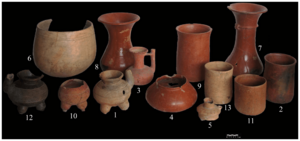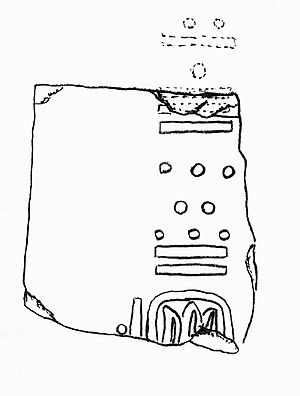Chiapa de Corzo (Mesoamerican site) facts for kids
Chiapa de Corzo is an archaeological site in Mexico. It's a place where ancient people lived long ago. The site is located near the modern town of Chiapa de Corzo, Chiapas.
This ancient city became very important between 700 and 500 BC. During this time, it grew into a major regional center. Its public area covered about 18 to 20 hectares (about 45-50 acres). The whole settlement was much larger, around 70 hectares (about 173 acres). Chiapa de Corzo was located near the Grijalva River. This position helped it control important trade routes. These routes connected it to other areas like Soconusco and other ancient cities.
The modern town of Chiapa de Corzo, Chiapas was founded much later. The archaeological site was named after this town.
Contents
History of Chiapa de Corzo
People have lived at this site for a very long time. Evidence shows continuous occupation since about 1200 BCE. This is known as the Early Formative period.
The large mounds and plazas you see at the site today were built around 700 BCE. Later, between 100 BCE and 200 CE, temples and palaces were added. These grand buildings were constructed at the end of the Late Formative or Protoclassic period.
Exciting Discoveries at Mound 11
In 2008, archaeologists made an amazing discovery. They found a huge collection of Olmec axes at the bottom of Mound 11. This collection dates back to about 700 BCE. It was only the second time such a large deposit was found in the Chiapas region. This axe deposit is connected to one of the earliest E-Group complexes in Mesoamerica. E-Groups are special arrangements of buildings used to track the sun's movements.
Even more exciting, in April 2010, archaeologists found a 2,700-year-old tomb inside Mound 11. This tomb belonged to an important leader. It is the oldest pyramid tomb ever found in Mesoamerica. This tomb is about 600 years older than other famous tombs. For example, it's older than those found at Tikal or Kaminaljuyu. Experts believe the tomb shows more connections to the Olmec culture than to the Maya.
Who Lived at Chiapa de Corzo?
Experts believe that people who spoke Mixe–Zoquean languages settled Chiapa de Corzo. These people were part of the Olmec culture. The Olmecs lived along the Gulf and Pacific Coasts of southern Mexico.
Around 700 BCE, Chiapa de Corzo and other nearby centers developed into a unique Zoque civilization. This culture was important. It acted as a link between the later Olmec society and the early Maya. Some important features of Mesoamerican cultures might have started in the Zoque region. These include planned cities, earthen pyramids, and early forms of writing.
Chiapa de Corzo as a Regional Capital
Starting around 100 BCE, Chiapa de Corzo became a very important regional capital. This was during its Guanacaste phase. The city had strong connections with other areas. These included the Maya Lowlands, Maya Highlands, Pacific Coast, and Oaxaca. This is also when the first hieroglyphic writing appeared. You can see it on stamps, pottery, and building panels.
Maya pottery styles started appearing in important burials. However, everyday pottery still kept traditional local designs. This suggests that the Maya culture, located to the east, had some influence over Chiapa de Corzo. But this Maya influence seemed to lessen in the first centuries CE. During this time, the old platform mounds were covered with limestone and stucco.
Why the City Declined
Big changes happened in the area between 300 and 400 CE. This was during the Istmo phase. The city faced an economic decline. Craft activities decreased, and long-distance trade slowed down.
Chiapa de Corzo and several other sites in the western region were abandoned. This happened by the Late Classic period. This population change happened around the same time as an invasion. A group of warlike people called the Chiapanec arrived.
The Chiapanec decided to settle in the nearby river floodplain. This is where the modern town is now located. They left the old Zoque ruins on the plateau untouched. The abandoned city then became a special place for pilgrimages.
Modern Discoveries and Protection
Over the last 70 years, the site has been affected by modern construction. Roads, homes, businesses, and even a cemetery have been built. In the late 1960s, a large milk processing plant was built right in the middle of the ruins. This construction removed Mound 17, which was a major ceremonial mound.
In recent years, the Instituto Nacional de Antropología e Historia (INAH) has been buying parts of the site. They are working to protect it. INAH officially opened a small part of the ruins to tourists on December 8, 2009. Researchers from Brigham Young University, INAH-Chiapas, and Mexico's UNAM are currently studying the site.
Important Finds at the Site
One of the most important finds is on Stela 2. This is actually an inscribed wall panel, not a traditional stela. It shows the oldest Mesoamerican Long Count calendar date ever discovered. The date is December 36 BCE. Only part of the original text remains, showing the day-name and the numbers 7.16.3.2.13.
Chiapa de Corzo is also famous for a piece of pottery. This pottery sherd likely contains Epi-Olmec script. It dates back to as early as 300 BCE. If confirmed, this would be the oldest example of that writing system found yet.
The site also has what might be the earliest example of a Mesoamerican palace complex. This palace is located in Mound 5. It was built in the first century CE. It was later ritually destroyed a couple of centuries later.
More than 250 ancient burials have been found and studied at Chiapa de Corzo. Many of these come from a special burial ground under the Mound 1 plaza. Chiapa de Corzo has the largest and most organized collection of burials from the Formative period in southern Mesoamerica.
The site also has more clay cylinder seals and flat stamps than almost any other Formative Mesoamerican site. Only Tlatilco has more. Hieroglyphs appear on some examples made around 100 BCE.
See also
 In Spanish: Zona arqueológica de Chiapa de Corzo para niños
In Spanish: Zona arqueológica de Chiapa de Corzo para niños






